Related Blogs
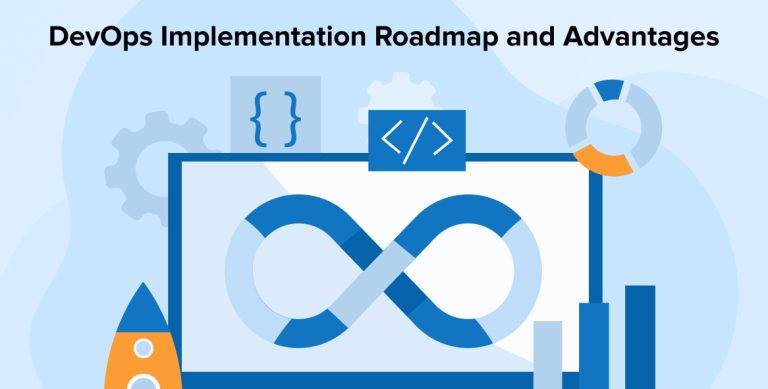
When it comes to software development, DevOps is a methodology that brings maximum efficiency. It is a flexible method that combines various tools, philosophies, and practices to offer agility in the development process. And this is why the majority of organizations are shifting from the traditional approach to DevOps Culture. But still, some companies fail to successfully implement DevOps, therefore, here in this blog, we will go through the DevOps implementation roadmap which can help you understand the implementation process thoroughly, and then we will have a look at the advantages of DevOps.
1. What is DevOps?
The term DevOps stands for the integration of two disciplines namely software development and IT operations.
Whenever something in the software goes wrong, both the development and operations teams often blame each-other. The concept of DevOps was introduced specifically to solve this problem.
It encompasses a set of principles that force collaboration between the development and operations teams to deliver efficient software products quickly. DevOps promotes teamwork and communication by breaking the conventional culture of working in silos, replacing it with agile and cross-functional teams.
Implementing DevOps involves a set of robust service functionalities like automation, CI/CD, and monitoring. These components work collectively under the umbrella of DevOps methodology to ensure a faster and more reliable software release.
A company that embraces DevOps can easily adapt to rapid changes in market trends and consumer behavior.
2. Planning a Successful DevOps Implementation
Combining two teams and adopting agile practices requires a thoughtful approach. Take one step at a time. Trying to do everything together will lead you to project failure. From startups to enterprises, everyone has to work on one stage of DevOps implementation at a time.
The only difference here would be that startups might have to do everything from the ground up. Whereas a large enterprise can make things work with little adjustments to their well-defined workflows. Moreover, small companies wouldn’t need robust automation capabilities. So, they can get their CI/CD pipelines up and running in no time.
It doesn’t matter if you are adopting or transitioning to DevOps, either way, you need a proper plan in place. Never ignore careful planning for it can make or break your project.
2.1 Assess Your Current Infrastructure
It’s true that DevOps is the need of time. But it is also necessary to know whether you truly need it or not. For that, assess your existing infrastructure, and workflows. That ought to help you understand the gaps in your system and its offering. Then it’s time to probe if DevOps really offers what you need. If that box is ticked off then move forward to the next step.
2.2 Choosing the Right Tools and Technologies
Picking the right tools and technologies doesn’t always mean you need to bring in the new ones. Take a look at what you are already using. If they can fulfill all your DevOps requirements then there is no need to make an unnecessary switch. For it can complicate your code and workflows as well.
The choice of tools and technologies depends on your requirements. For example, you can pick AWS Codepipeline for easy AWS cloud deployment whereas Kubernetes is ideal for container orchestration. Same goes for automation, collaboration, integration, scalability, efficiency and other requirements. Remember, the working of the tools must align with your objectives and help you streamline the DevOps process.
2.3 Developing a DevOps Implementation Roadmap
To reach your destination, you need a right roadmap. Here, you have to create one for yourself. As every roadmap would have, you need clear objectives, milestones and timelines. The assessment from the previous step would help identify the work that needs to be done in this project.
When drawing out a roadmap, you have to adopt a structured approach, ensuring that each stage of DevOps implementation is taking you a step closer towards your business objectives.
3. DevOps Implementation Roadmap
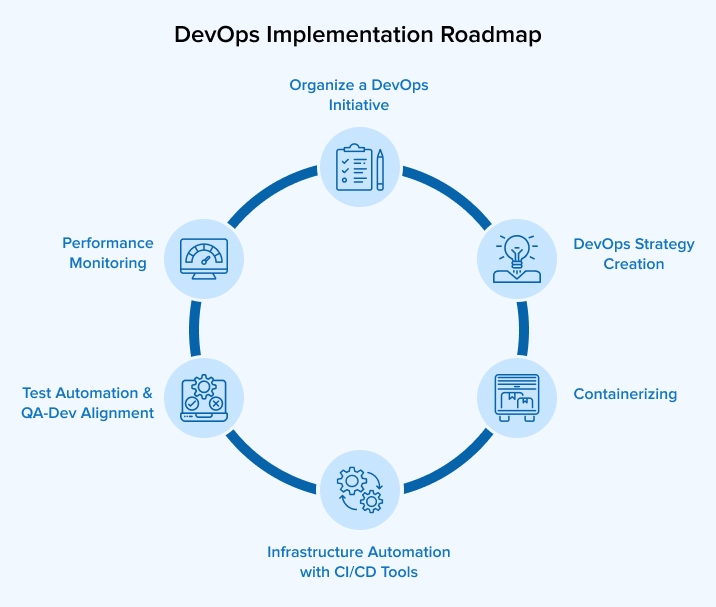
DevOps implementation is a concept that integrates operations, development, and testing departments together in cross-functional software development teams. The main aim of this is to improve the agility of the IT services. Basically, the approach of DevOps implementation is categorized into three sections – DevOps Continuous Integration (build), DevOps Continuous Testing (test), and DevOps Continuous Delivery (release). And this helps companies to shift from the traditional approach and change the development methods as per the DevOps concept. For this, a few steps must be taken into consideration and they are –
3.1 Organize a DevOps Initiative
The first step to follow while shifting from the traditional software development method to DevOps is to organize a DevOps initiative for the IT department. By doing so, all the team members will get an opportunity to make necessary changes in the operational and development phases. In this initial phase, the CIO of the IT firm organizes everything and arranges financial investments in the best way possible. Besides this, the program manager will be responsible for designing and monitoring the DevOps implementation process.
3.2 DevOps Strategy Creation
The next step is to start creating the DevOps strategy which means that the project manager will use DevOps tools, principles, and best practices that can help in improving interdepartmental collaboration. Besides, it also includes coming up with new ways of software development & testing, and infrastructure provisioning. Some of such best practices are –
- Automate software development, unit testing, software integration, application testing via UI, deploying, and launching different processes to speed up the software development and testing releasing cycle.
- Another practice is to implement IaC that ensures the early provision of the IT infrastructure as per the request of software developers and testers. And this is required while developing a new build or checking its quality. This process enables the DevOps experts to get new software development & testing infrastructure and avoid human errors.
3.3 Containerizing
After creating the DevOps strategy, containerization is implemented. For this, tools like Docker are used to solve software reliability issues. In this process, containers come with everything that is needed to run an application. Here, various pieces of applications are put together into several containers and this makes it easier for the operations team to update an app as it doesn’t require rebuilding the entire application when there are only smaller changes.
3.4 Infrastructure Automation Integration with CI/CD Tools
When a software application is put into containers, managing the containerized application is very important. For this process, infrastructure automation tools like Puppet, Chef, Ansible, CloudFormation, and Kubernetes are used with CI/CD tools such as Azure DevOps, AWS Pipelines, GoCD, Jenkins, and Bamboo. This integration enables efficient software deployment and configuration management.
Let’s make it more simple by having a look at an example. For instance, if the developer uses Kubernetes for large infrastructures and or Ansible for smaller app infrastructures, this enables the team to monitor the container’s health, manage containers for fault tolerance, and roll software updates. After that, when it comes to creating, testing, and deploying new builds in the Kubernetes tools, it can be done using Jenkins.
3.5 Test Automation and Aligning QA with Development
The next step is to achieve faster delivery with the help of DevOps. For this, software development teams need to carry out sufficient automated testing. However not each type of testing can be automated; therefore, the team needs to perform usability, exploratory, and security testing manually. This still depends on the efforts required for automated testing. Besides this, the DevOps experts must carry out development and testing activities in tandem to avoid bugs before releasing the build.
3.6 Performance Monitoring
The last step that comes in converting a firm’s traditional approach to DevOps, application performance monitoring, is required. It helps in offering transparency over various performance problems to the DevOps teams. All these problems can be revealed during the processes like user experience monitoring, application server monitoring, and more. Here, application performance monitoring enables isolating, detecting, and prioritizing the defects of the app before the user finds them and for this tools like Nagios and Prometheus are used.
4. Advantages of DevOps Implementation
DevOps is used by developers to overcome the drawbacks that traditional software development methods and to carry out modern IT operations. With a wide range of new technologies and practices available in the market, software development companies find it easier to implement DevOps and start developing, testing, and deploying apps faster than organizations that are still utilizing traditional approaches. To know more about this, here we will go through some of the main advantages of DevOps and see how it is changing the way software developers work –
Learn how Infosys helped one of the world's largest #banking organizations to increase productivity & enable enterprise agility on the #mainframe through #DevOps implementation. Read the story here: https://t.co/KJAtXZyHMZ #NavigateYourNext pic.twitter.com/trNls7xVJ8
— Infosys (@Infosys) April 30, 2019
4.1 Constant Communication among All the Teams
When it comes to using DevOps, it is not just about picking the right methodologies and tools. It’s also about right and constant communication between the team members while implementing. This is why project managers say there must be proper communication among team members at every stage of software development.
And to achieve smooth communication during DevOps implementation, companies must introduce open-source communities like GitLab, to provide their teams with a platform that can help in planning, creating, verifying, and releasing the software while collaborating with other team members. In this case, the one thing that matters more is team members’ understanding of behavior and mutual responsibility for each other. This is essential as it enables the software development team members to realize the importance of faster releases.
Basically, constant engagement between the team members enables them to have a common goal and focus completely on providing user satisfaction. In addition to this, organizations must also promote a knowledge-sharing environment which helps in improving the business perspective.
4.2 Fewer Software Failures
One of the most important things about DevOps implementation is having a proper understanding of the application being developed and knowledge of its requirements. This helps in aligning the infrastructure design with the firm’s goals and making a business-dive DevOps implementation. Here, all the project’s release cycles are assessed and environments are tested to identify potential bottlenecks and areas for improvement.
Successful implementation of DevOps is incomplete without incorporating continuous deployment and integration into your workflow. And this is because when there is continuous integration, the development team gets a chance to create regular, small stages and identify the issues and resolve them early. Besides, the continuous delivery allows them to deploy all the changes in production frequently.
4.3 Fast Provision of New Infrastructure
When the DevOps team wants to quickly prepare and deliver new infrastructure for software development, designing, testing, and production, they apply the IaC approach. This means that when the infrastructure exists as a ready-made code phase, the DevOps developer would require new infrastructure for a new project, and for that, they won’t have to wait till the system administrators offer it.
4.4 Test Automation
With the implementation of DevOps, continuous testing will be possible. And this is one of the biggest advantages of the DevOps approach. So to achieve it, the DevOps team uses specialized tools that test everything automatically. For instance, Zephyr, Selenium, and Tricentis Tosca are tools that are designed to automatically perform different tests like functional testing, unit testing, and integration testing. These tools can notify the DevOps experts immediately when bugs are detected.
4.5 Quick and Reliable Delivery of Application Updates
Because of the collaboration between ARA (application release automation) and the DevOps-related teams, the software can be updated much faster than in the traditional method. ARA enables the deployment process to accelerate with minimal configuration errors and downtime that might occur when a new build is being deployed manually.
Agility due to #DevOps implementation can lead to 30x faster deployments. http://t.co/5XfDZRYtVS #ALM #VMWorld
— Capgemini (@Capgemini) August 26, 2015
4.6 Reduced Number of Errors
With the DevOps implementation, when there is a continuous testing process going on and it is aligned with the production environments, the quality analysis team will have to spend less time in the testing process and still, no errors will be missed.
4.7 Improvement in Users’ Trust
DevOps increases the rate of test automation and reduces the number of post-release errors. When any company is implementing DevOps, they can easily convince the business users of the software’s quality and for that, one thing that they can do is have excellent communication within the team and with the users. The development team can involve end-users in defining the tests to be automated, which ensures sufficient testing coverage.
5. Challenges in DevOps Implementation
DevOps has proved to be a game-changer in the field of software development. But having a disruptive player isn’t enough. To win the game, it is necessary to overcome challenges as well. Take a look at the top challenges your organization might face during DevOps implementation.
5.1 Cultural Resistance
The implementation of DevOps makes some great shifts in the workplace culture. Both development and operations teams might be used to work in silos. There might be some resistance as you try to bring them together through DevOps best practices.
After all, humans don’t like change, especially when they are comfortable with their existing conditions. This can cause some delays in DevOps implementation and cause conflicts within the team.
However, all these can be resolved with a slow and gradual adoption of DevOps. Once they become familiar with the concept and start experiencing the benefits, they will be more open to change.
5.2 Moving From Legacy to Microservices Infrastructure
Implementing DevOps tools and processes is difficult when you have an outdated app and infrastructure. Using it would only increase your problems. You need to make a transition to DevOps.
But the problem is that these systems were not designed keeping DevOps in mind.
But not all hope is lost. You can either phase it out completely or prepare a replacement version maintained by DevOps and transfer all your users bit by bit.
5.3 Lack of Metrics and KPIs
A success is always measured upon predetermined metrics. But in the case of DevOps, it is hard to decide the metrics or KPIs of the process. Why? Because it is a combination of two departments that have separate objectives and working systems.
Due to that, both teams might not easily agree on common KPIs. Without the KPIs, how are you supposed to track the performance of your process? The only way out of this pothole is to define metrics that can track the progress toward your common organizational goals.
5.4 Tool Integration
DevOps implementation is not just a combination of two departments or teams working together. It is also an amalgamation of several activities like source code management, automation, monitoring, and more.
The problem is not that there are different activities to do in DevOps. The problem is you need a separate tool for each. As you may know, not every tool is compatible with your application infrastructure.
To resolve this matter, you have to adopt an integrated toolchain. Here, you will be selecting tools that are designed to work together.
5.5 Cost and Budget
You might have to loosen up your pocket for effective DevOps implementation. The initial investment is only far too great for any company. You have to adopt new technologies, integrate different tools, train employees, migrate older systems and more. Each one of these would be an expensive undertaking. When you add them together, the DevOps benefits wouldn’t seem so lucrative anymore. Remember, having a buffer budget always helps in such scenarios.
6. Conclusion
As seen in this blog, when any company decides to implement DevOps, they must consider various things like implementation time, new technologies, and organizational efforts that are required for the successful initiation of DevOps. This success of its implementation enables the development teams to deliver software more rapidly without compromising the quality of the software or the process. For all this to happen, the transformation of both the IT infrastructure arrangement and the software development process is required. DevOps can help in making the IT infrastructure of any firm reliable with the help of the strong collaboration between the DevOps-related teams.
Basically, DevOps implementation and following DevOps principles and best practices like IaC, CI/CD, total application monitoring, testing automation, and others can help in changing the entire approach of the organization.

Vishal Shah
Vishal Shah has an extensive understanding of multiple application development frameworks and holds an upper hand with newer trends in order to strive and thrive in the dynamic market. He has nurtured his managerial growth in both technical and business aspects and gives his expertise through his blog posts.
Related Service
Software Development Services
Learn more about our Software Development Process
Learn MoreSubscribe to our Newsletter
Signup for our newsletter and join 2700+ global business executives and technology experts to receive handpicked industry insights and latest news
Build your Team
Want to Hire Skilled Developers?

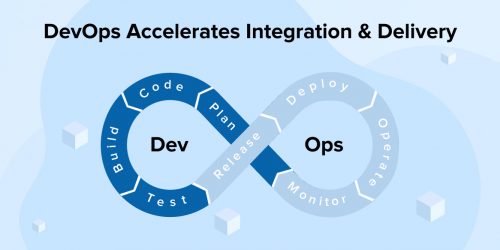
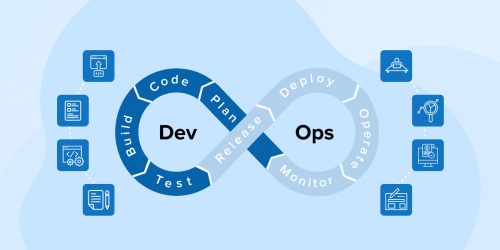
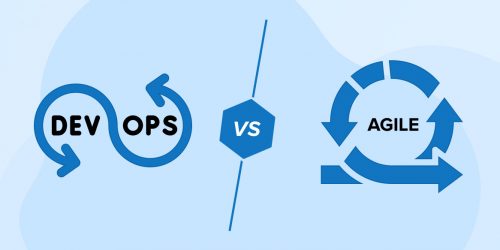

Comments
Leave a message...